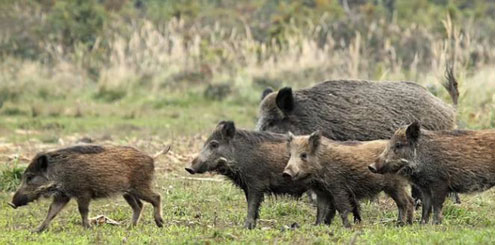The importance of control cannot be overstated when considering the sheer scale of the harm. In 2024 alone, agricultural losses in Texas exceeded a staggering $670 million due to feral pig activity. Furthermore, landowners across the state are currently spending over $130 million annually just on control costs.

Beyond the financial destruction, feral pigs are known to cause water quality impacts, compete with native animals and livestock, and pose a serious disease threat to humans, livestock, and wildlife. Their ecological impact is visibly devastating, marked by rooting, the upturning of soil used to find subterranean food, which causes massive damage across pastures, rangelands, and forests, slowing the ability of these disturbed areas to recover. Additionally, their wallowing behavior loosens soil, leading to increased sedimentation and impairment of water quality and aquatic life.
A changing landscape demands new approaches
While landowners in rural areas have dealt with these resilient animals for decades, the current challenge is amplified by Texas’s unprecedented population boom. Texas is experiencing rapid metropolitan growth, from 19 million to 29 million people in 20 years, with a projected growth to over 40 million by 2050. Over 86 percent of this growth has occurred in just 25 counties, leading to land ownership fragmentation and pushing metropolitan areas into formerly rural working lands
This shifting landscape means that feral pig encounters and incursions into developed areas are on the rise. Landowners on small-acreage properties (less than 100 acres) and those residing in metropolitan areas face unique hurdles. For example, city codes, county ordinances, or Homeowners Associations (HOAs) often restrict the discharge of firearms or the setting of traps.
Tailoring management to restricted spaces
Given these legal and physical constraints, management plans must be adapted. Fortunately, the state classifies feral pigs as “exotic livestock,” not as wildlife, meaning there is generally no hunting season or bag limit, and on private property, no hunting license is required. This regulatory framework allows for flexibility, but urban restrictions still necessitate careful choices among control methods:
Trapping is a proven and effective method suitable for nearly all landowners. Options include animal-activated, human-activated, and continuous traps. Neighbors can collectively purchase and utilize an advanced smart trap across a neighborhood to manage populations and reduce the cost burden. Furthermore, commercial companies often offer trapping services and handle the removal and extermination of feral pigs where firearm use is prohibited.
Fencing, though costly, is more feasible on small acreage compared to large ranches. While exclusion fences are expensive (up to $13,251 per mile), electric fencing offers a less permanent, psychological barrier at a fraction of the cost ($1,243 per mile).
Toxicants offer a non-firearm alternative, gaining traction. Kaput®, the only legal toxicant in Texas, was legalized in February 2024. While highly compelling for areas restricting firearms, its use requires an applicator’s license through the Texas Department of Agriculture (TDA) and careful communication with neighbors, as poisoned pigs may die on adjacent properties.
The path forward: Education and collaboration
Feral pig management will only succeed if wildlife professionals, local officials, and landowners commit to working together.
Landowners, especially new and beginning landowners (those with less than 10 years of experience), have multiple resources available, including County Extension Agents (CEAs), Extension Specialists, and the Texas A&M Natural Resources Institute (NRI), which has developed dozens of resources specifically to assist with managing feral pigs.
However, greater systemic change is necessary. City and county officials must examine existing rules and regulations to allow for better management alternatives on acreage under their restrictions. Ultimately, neighbors joining together, whether to implement management across larger areas or to share the financial burden of hiring professional services, will likely be the best way forward to reduce the destructive tide of this invasive species. Without aggressive and tailored action, the biological success of the feral pig will continue to compromise the economy and environment of the rapidly evolving Texas landscape.


